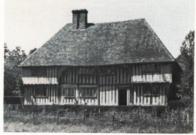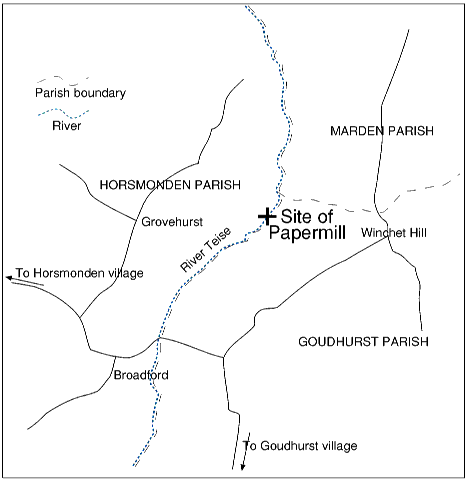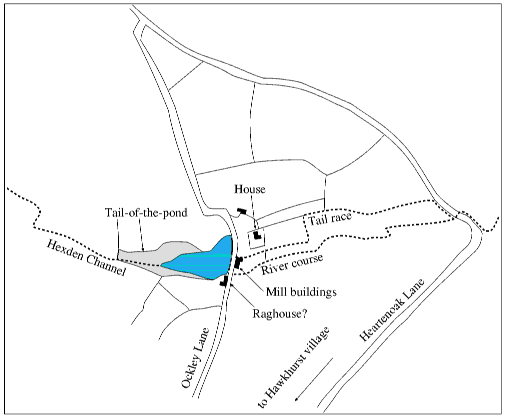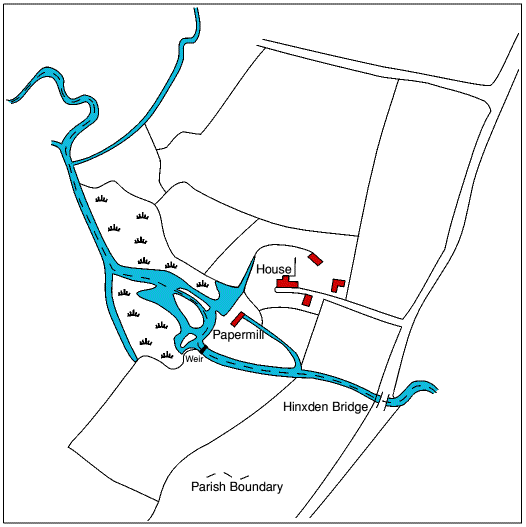Papermaking in the Weald of Kent |
|
The first recorded papermill in England was built by John Tate near Hertford in about 1490, where the River Lea provided not only the water power but a means of transport to London for the finished product. Most paper at this time was imported from France via Holland, where Caxton obtained his supplies. As with many technologies, papermaking was developed in China but the skills had not reached southern Europe until the 12th century, brought by the Moors into Spain and Italy. The earliest paper made in England was made from hemp ropes and old linen cloth; in coastal areas, even old sails were used (1). It is John Spilman, a German jeweller to Queen Elizabeth, who is credited with the first successful production of high quality white writing paper. He was granted a lease of two royal watermills on the River Darenth in Northwest Kent and converted them to produce paper, employing skilled German paper-makers. Perhaps it is not surprising to discover that, within a generation, enterprising individuals had erected papermills or converted earlier watermills in Benenden and Goudhurst to make paper. In the latter case, we know this from the rather tragic entry in the Goudhurst parish register: 1634 Aug 18th buried Ellen Porter dau of Samuel Porter, being killed in a paper mill At about the same time, another papermill was in operation in Benenden on land owned by the Plummer family of Milkhouse Street (now Sissinghurst). They commissioned surveys of their estates in about 1640 and a book of maps was compiled which includes one of "The Paper Mill", a small holding of about nine acres in the northeast corner of the parish near Bishopsden. Thomas Plummer purchased the property in 1633, the deeds describing it only as a watermill, so it is possible that he converted a fulling mill or corn-grinding mill to produce paper. The tenant, Zachary Duke, witnessed the deed of sale, and was probably the miller/papermaker. Unfortunately, there is no documentary evidence relating to the property after 1650 and so it is not known how long the mill was operational. (2) However, the papermill in Goudhurst was a more thriving concern as there are several references to papermakers there during the 17th century. Thomas Gulvin of Goudhurst, paperman, was married at St.Dunstan's in Cranbrook in 1656 and a papermaker of the same name died in Marden in 1690. In 1657, Robert Wilson, a papermaker from Goudhurst, was married at All Saints, Maidstone, and Edmond Rhod (a variant spelling of Roades), paperman, died in 1668. (3) All three were probably employed by Thomas Willard who, in 1666, was leasing the Goudhurst paper mill from a papermaker, Richard Roade of Bedhampton in Hampshire, no doubt a descendant of the extensive Roades family of Goudhurst (4). Various members of this family were making cloth and manufacturing sickles and scythes from local iron and steel in Goudhurst during the previous one hundred years. From this lease, we learn that Thomas Willard was in arrears, owing £50 rent for the mill and its adjoining lands, and so it was agreed that, in consideration for the outstanding sum and an additional five pounds, his landlord was to have the benefit and profit of two plots of wheat ground (the crop being growing now), part of the Mill's lands, and the profit of Thomas' moyetie of one and a half acres of flax also on the mill's ground. Thomas was to reape drawe and harvest the said wheat and flaxe at the next harvest in good husbandlike manner and put it into the mill's barn or other convenient store.
Fields with names such as "Paper Mill Field" occur in the Goudhurst and Horsmonden Tithe Apportionments suggesting that it was on the river Teise or powered by a leet from it. (5) The papermill is mentioned by name in the Goudhurst rate books when they start in 1683-4 although later the less definite phrase "Paper Mill Lands" appears; the property passed through several hands, chiefly members of the Gulvin family of papermakers, who also appear in Marden and later in Horsmonden, where a papermill was rated to George Gulvin from 1716. Whether this is the same mill seems unlikely as the river Teise is quite wide at this point. It is more probable that a new mill was erected or another one converted across the river in Horsmonden parish. According to the rate books, the mill had several operators: from 1718, John Osborn was assisting Gulvin in running the mill until 1725 when Thomas West took over. Members of the Blackwell family must have come to work at the paper mill in Horsmonden during the 1730s as the parish register records the burial of William in 1738. Two of Edward and Sarah Blackwell's children were baptised in Horsmonden in the 1740s and when Thomas West died in 1748, Edward Blackwell appears to have assumed responsibility as he paid the rates. It is possible that the Blackwells came from the Dartford area, where a century before, a William Blackwell was managing Spilman's papermill, and another papermaker, George Blackwell, was buried in 1710 (1). However, no connection has yet been established. We have no way of knowing how up to date the machinery at these papermills was. The earliest mills were often adaptations of fulling mills previously used in the finishing of cloth but made redundant by the decline of that industry. Such a papermill would need a steady supply of rags, which had first to be sorted, as it was the condition (and colour) of the starting material that determined the quality of the finished paper. There were no chemical bleaches, so the whitest rags made the whitest paper. This work, done by women, was probably fairly unpleasant as the rags were dirty and may possibly have carried disease. After cutting into small pieces, the material may have been retted, ie wetted and left to ferment for a day or two to help break down the weave. Next, the rags were beaten in water to produce a fine pulp. They were added to a trough of water and were pounded by several hammers. These were raised by cams on the waterwheel spindle, and then fell by their own weight onto the wet rags. The first beating, for 12-18 hours, used hammers with spikes set into the heads (and a metallic lining in the bottom of the trough) which cut and shredded the rags to produce "half-stuff", mostly individual threads. Beating in a second trough for a further 12 hours, using hammers set with studs having grooved heads, broke up the threads to give a pulp of a finer consistency, called "whole-stuff". Beating in a third trough for several more hours, using plain wooden hammers, produced the desired result, a pulp of fine separated fibres, called "stuff". The stuff was then transferred to a vat of clean water to produce a milky suspension of white cellulose fibres. The "vatman" had the job of producing the paper sheets using a mould. The mould is a fine metal mesh fixed to the underside of a rectangular wooden frame, like a fine sieve. The skill is to scoop up the correct amount of suspended fibres in the mould to form a sheet of paper of the required thickness and to gently swirl or agitate while the water drains away, leaving an even layer of fibres on the mesh. The vatman worked in partnership with the "coucher" who took the mould and transferred the wet layer of fibres onto a damp woollen cloth called a felt. The sheet was then covered with another felt and the next sheet of paper laid on top to make a stack called a "post". The post was put into a screw press to remove as much moisture as possible. A third man, the "layer", separated the felts and sheets of paper, returned the felts to the coucher and stacked up the sheets of paper ready for an additional pressing, after which they were hung up in the lofts of the mill to be air-dried. If the paper was to be used for writing, it would have to be sized to make its surface less water absorbent. It was claimed in 1816 that these three skilled men could make four thousand small sheets of paper in a day (1). The Horsmonden mill probably only had one vat but had closed by 1754-5 as Edward Blackwell leased a dilapidated fulling mill at Ockley in Hawkhurst in 1754 for 31 years (6). The lease specifically states that he was to repair the "demised buildings" and build a paper mill and insure it against fire. The work must have been completed by April 1755 when he took out his policy with the Sun Fire Insurance Office. His new "timber and tiled papermill" was insured for £240 and the "Utensils and Stock therein" at £70. A separate Raghouse for storing the rags was insured for £30 which must have been substantial since his dwelling house was insured for only twice that value. (7)
News quickly spread and people came considerable distances to sell rags and buy Blackwell's paper. Thomas Turner, a shopkeeper in East Hoathly, midway between Heathfield and Lewes, recorded in his diary on 12th July that year: This day sold Mr Blackwell of Hawkhurst all my white rags at 27s per cwt., and bought of him 12 couple of white pound and half-pound paper, 8 reams of midd[ling] hand ditto at 4s., 2 reams of brown cap and 1 ream of 2lb. ditto at 4s 3d ... He must have been well pleased with the paper as he records further purchases in his diary, sometimes paying in rags with a cash adjustment (8). It is interesting to note that the Ockley mill was producing several grades of both white and brown paper and it is likely that building a new mill from scratch, Blackwell was able to install modern machinery, including a "Hollander" often referred to as an "engine" for beating the rags and greatly increasing his productivity. However, like most papermills of the period, he probably only had a single vat. Edward's landlord, James Stanford, styled himself "gentleman" but had made his money through smuggling activities with the Hawkhurst Gang and had invested in property (an example of 18th century money-laundering). Shortly after, he moved to Edenbridge where the long arm of the law finally caught up with him. He wrote his will while awaiting trial and left "Fulling Mill Farm" ie Ockley Farm in Hawkhurst to his two brothers to sell (9). As with any new business it soon became necessary to train new employees and, in 1756, Edward Blackwell turned to the overseers of Hawkhurst parish to supply an apprentice (10). The apprenticeship indenture of Samuel Kingswood, dated 1st May, was from Lady Day last past for 10 years. No fee is mentioned but it included the usual lengthy list of what an apprentice was not allowed to do, such as he should not commit fornication nor contract matrimony. He was to be paid 18d per quarter, given appropriate clothing and when his ten years were over, was to be given two suits, one for Sunday and one for workdays. The Ockley mill must have been a success over the next ten years as Edward sought to expand his business and develop new premises. There had been a corn-grinding watermill at Hinxden in Benenden (close to the Hawkhurst parish border) for centuries and at this date it was owned by the Earl of Halifax. He first paid the rates for the property in 1770 but he may have converted the earlier mill buildings to make paper a few years before. A lease of Mill Farm dated November 1765 states that Edward Blackwell, papermaker, was tenant of the mill site, and had the use of part of the house, its garden and barn. His son, William, having had three children baptised in Hawkhurst, moved to Benenden at about this time, where the baptisms of four more children are recorded, so it seems highly likely that the papermill was built then and William was put in by his father to manage it. The papermill soon became part of the Hemsted estates and the waterways are quite clearly marked on an estate map surveyed in 1779.
In 1785, Edward must have renewed his lease of Ockley Mill in Hawkhurst as he revised his fire insurance policy. However, he died in the following year, leaving his other son, Edward, in charge. In the following year, William and Henry (an error for Edward?) Blackwell took out new fire insurance policies to cover both papermills, each being insured for £200 with utensils and stock insured for £70 at each (7). William had seven children by his first wife, Martha, but within about a year of her death in January 1792, he had got Ann Huggins pregnant and she gave birth to an illegitimate daughter in December 1793. Somewhat belatedly, in February 1795, they were married (when William was 56 and she was 17!) and they had six more children. Although operating separate papermills, the brothers, William and Edward, worked in partnership for the next decade but in 1796, they decided to work independently and announced the decision in the Kentish Gazette in November, stating that they would only be responsible for their own personal debts. A survey of the Benenden estates of Thomas Law Hodges made in 1801 describes the papermill and land and Mill Farm (12). John Blackwell leased just over five acres at £10 pa and shared the house with the farmer, William Croft, who farmed 62 acres. Of the papermill, the surveyor wrote: The buildings consist of a small paper-mill and also a pair of stones for grinding wheat and other corn. There appears to me to require much money to be expended in clearing the pond head and rivulet; at no time I should think it capable of doing much: there appears rather a degree of poverty about the premises. Looking at the flat meadow in front of "The Paper Mill" house today, it is difficult to imagine how any head of water could be created but silting up must have occurred over the centuries and it seems likely that the mill wheel was undershot. The Blackwell and Croft families must have been thrown into each other's company continually and it is perhaps not surprising to find in the Benenden parish registers:
1834 Feb 16 bap.Henry s of Martha Croft, base born (father Thomas Blackwell)  The House shared by the Croft and Blackwell families. When William Blackwell died in 1806, his will directed that: By this date, Edward Blackwell had passed the management of Ockley Mill to John Blackwell and had a small farm at Hartley. The mill was then owned by the Durrant family of Hawkhurst, substantial landowners in the parish. Under John's management the mill seems to have thrived because the names of several papermakers appear in the Hawkhurst parish registers, Anthony Fox, John Gough, Thomas and Edward Jenner, John Sevenoaks, Joseph Mann and David Thatcher. Hawkhurst parish was surveyed in 1818 to produce a splendidly detailed map which shows a sizeable millpond providing power to Ockley Mill . In 1820 John Blackwell took on James Christmas as an apprentice, the 14year old son of Thomas Christmas, a private soldier in the Seventy Second Regiment of Foot now at the Cape of Good Hope. His mother was dead and his father had left the boy in the care of the parish. James had to serve his master until he was 21 (ie 7 years) and the parish paid John Blackwell £10 to teach him the skills of papermaking (14). However, the mill soon became of secondary interest to John Blackwell as he invested his profits in land and concentrated less on making paper and more on farming. By 1830, he had purchased a farm at Tubslake and was leasing Baretilt Farm (which he later purchased) and the last mention of the papermill in the rate books is in August 1832 (15). By the time of the Tithe Apportionment survey in 1840, the pond was drained. In Benenden, Thomas and Richard (Barber) Blackwell continued to make paper at Hinxden although Thomas died in 1830. His son, also Thomas, continued in the business with uncle Richard; they are listed as papermakers in later trade directories and in the 1841 census. By this date, the water supply and the equipment they had was becoming inadequate to compete with the increasingly mechanised and larger mills in the Maidstone and Dartford areas and it is difficult to believe that much paper was made after about 1850, although the papermill was still recorded in a trade directory of 1855. A deed of April 1857 describes Hinksden Mill as a flour mill formerly a papermill (the millstones from the earlier cornmill had probably never been removed) although it is hard to believe that much flour was produced at this date, perhaps just a little from corn grown on the adjoining farm (16). Clearly, the Blackwells had abandoned the manufacture of paper and when Richard Blackwell (probably the driving force as the senior member of the family) died in November 1857, aged 61, papermaking in the Weald of Kent came to an end. As a footnote, John Blackwell, the last Hawkhurst papermaker, had a son who continued in the paper business but as a bookseller in Reading. Was he connected to the famous Blackwell's Bookshops in Oxford? References: (CKS = Centre for Kentish Studies) Previously published by Tony Singleton in The Cranbrook Journal No.16 (2005). |
| Back to Home Page | |



